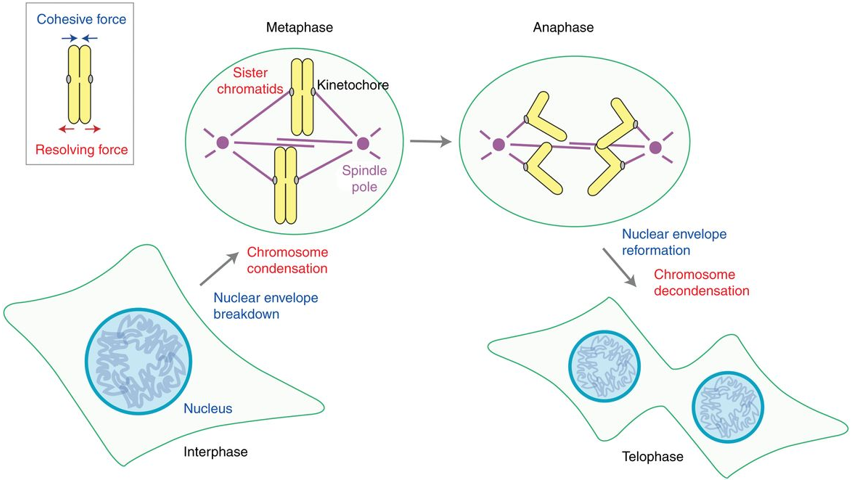Chromosome Dynamics Services
Chromatin Dynamics
Dynamic changes in nuclear structure and chromatin organization regulate important cellular processes, including epigenetics, DNA replication and repair, genome stability, gene expression (transcription), and cell cycle. These gradually developed into sub-disciplines of chromosome biology and chromatin dynamics. Progressive chromatin is no longer as previously understood, but "organelles". Chromatin dynamics are regulated by proteins that interact with the nuclear lamina and envelope. Existing knowledge indicates that changes in nucleosome packaging, cell cycle, staining system chains, and external forces acting on the nucleus in response to external and internal stimuli can change the basic mobility of DNA in the interphase nucleus. High-resolution tracking of chromatin dynamics has helped the formation of high-order folding and flexible guiding models of chromatin polymers, such as molecular biology techniques such as FISH.
 Fig 1. Overview of chromosome dynamics during mitosis. (Hirano T, et al. 2015)
Fig 1. Overview of chromosome dynamics during mitosis. (Hirano T, et al. 2015)
Available FISH Technology
Chromosome biology has been developed in recent years. It is a branch that studies the influence and mode of action of chromatin movement on gene expression. Most of the researchers are interested in the specific development of chromosome dynamics in the process of gene expression. Many of the techniques used to measure the movement of chromatin and the latest advances in biophysical analysis to simulate them have given people a certain understanding of the dynamics of chromatin and the polymer structure behind it. A series of FISH techniques (metaphase, interphase, mechanically stretched chromosomes (MSC) and FISH on fibers on free chromatin) can be used to construct and characterize high-resolution physical maps of positional cloning projects. Both mid- and inter-phase FISH techniques are used to determine the low-resolution distance between restricted markers. FISH using MSC confirmed the centromere-telomere sequence of the clones and helped estimate the size of the gap between clones.
 Fig 2. FISH technical services available in chromatin dynamics research.
Fig 2. FISH technical services available in chromatin dynamics research.
Available FISH Services
Creative Bioarray's Chromatin Dynamics Experiment Division is committed to providing the most comprehensive FISH technology related to chromosome analysis, as well as developing multiple FISH services that combine FISH and other technologies. Through our comprehensive FISH analysis platform of the Chromatin Dynamics Experiment Division, the following related analyses can be completed.
- FISH experiment and chromosome analysis;
- Verify the chromosome position of the clone/probe;
- Characterization of transgenic locus;
- Assess chromosome content and gene copy number;
- Verification of genome structure and copy number variation (CNV);
- Some technical services that are cross-used with FISH, such as Immuno-FISH;
- Identify chromosomal abnormalities in patients or individuals showing certain clinical symptoms of specific diseases and analyze candidate regions to verify the authenticity of the cell line;
In addition to the general FISH hybridization experiments (DNA-FISH and RNA-FISH), the combination of cytology techniques available in our Chromatin Dynamics Division also includes M-FISH, chromosome analysis, karyotype analysis, and chromogenic RNA in situ hybridization on tissues.
Creative Bioarray provides a variety of technical service options for the analysis of chromatin dynamics research, helping our customers obtain high-resolution FISH maps and comprehensive bioinformatics data mining. You will benefit from our technical expertise and advanced equipment platform, and work with you to explore the knowledge of chromatin dynamics. If you are interested in our FISH technical services mentioned above, please contact us for cooperation. We look forward to cooperating with you in the near future.
References
- Hirano T. Chromosome dynamics during mitosis[J]. Cold Spring Harbor perspectives in biology, 2015, 7(6): a015792.
- Seeber A, Hauer M H, Gasser S M. Chromosome dynamics in response to DNA damage[J]. Annual review of genetics, 2018, 52: 295-319.
All products and services on this website are only suitable for non-medical purposes.


 Fig 1. Overview of chromosome dynamics during mitosis. (Hirano T, et al. 2015)
Fig 1. Overview of chromosome dynamics during mitosis. (Hirano T, et al. 2015) Fig 2. FISH technical services available in chromatin dynamics research.
Fig 2. FISH technical services available in chromatin dynamics research.


